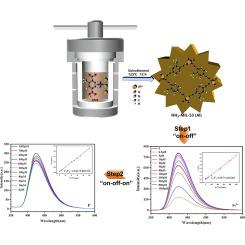构建“开-关-开”荧光系统,综合有效检测NH2-MIL-53(Al)水中的Fe3+和F−
IF 5.4
3区 化学
Q1 CHEMISTRY, INORGANIC & NUCLEAR
引用次数: 0
摘要
金属有机骨架具有独特的荧光传感特性,在离子检测中具有潜在的应用价值。本文采用溶剂热法合成了具有本然荧光性能的mof材料NH2-MIL-53(Al),通过“开-关”系统对Fe3+和F−进行了顺序检测。结果证实,应用NH2-MIL-53(Al)对一系列含有0.01 M金属阳离子的溶液均有荧光检测,Fe3+几乎会荧光猝灭,说明NH2-MIL-53(Al)对Fe3+有特异性识别。该传感器能够定量Fe3+,检测限为0.392 μM。用适当浓度的Fe3+猝灭NH2-MIL-53(Al)的荧光后,一系列阴离子检测表明,F−能在一定程度上恢复被猝灭的荧光。该传感器能定量测量F−,检测限为6.019 μM。因此,制备的NH2-MIL-53(Al)具有检测范围宽(0 ~ 1000 μM)、检出限低、回收率高等特点,可有效检测水体中的Fe3+和F−,是监测Fe3+和F−污染水体的理想选择。本文章由计算机程序翻译,如有差异,请以英文原文为准。

Integrated effective detection of Fe3+ and F− in water of NH2-MIL-53(Al) by constructing a “on-off-on” fluorescence system
Metal-organic Frameworks (MOFs) have potential value in ion detection due to their unique fluorescence sensing properties. Herein, NH2-MIL-53(Al), as one of the MOFs materials with intrinsic fluorescence performance, was synthesized by solvothermal method for sequential detection of Fe3+ and F− by a “on-off-on” system. Results confirmed that the application of NH2-MIL-53(Al) on a series of solutions containing 0.01 M metal cations are fluorescence detection, Fe3+ will almost fluorescence quenching, indicating that NH2-MIL-53(Al) has a specific recognition of Fe3+. The sensor could quantify Fe3+ with a limit of detection of 0.392 μM. After quenching the fluorescence of NH2-MIL-53(Al) with appropriate concentration of Fe3+, a series of anion detection showed that F− could restore the quenched fluorescence to a certain extent. And the sensor could quantify F− with a limit of detection of 6.019 μM. Therefore, the preparation of NH2-MIL-53(Al) can effectively detect the Fe3+ and F− in the water with the characteristics of wide detection range (0–1000 μM), low detection limit and high recovery rate, making it a promising candidate for the monitoring of Fe3+ and F− polluted waters.
求助全文
通过发布文献求助,成功后即可免费获取论文全文。
去求助
来源期刊

Inorganic Chemistry Communications
化学-无机化学与核化学
CiteScore
5.50
自引率
7.90%
发文量
1013
审稿时长
53 days
期刊介绍:
Launched in January 1998, Inorganic Chemistry Communications is an international journal dedicated to the rapid publication of short communications in the major areas of inorganic, organometallic and supramolecular chemistry. Topics include synthetic and reaction chemistry, kinetics and mechanisms of reactions, bioinorganic chemistry, photochemistry and the use of metal and organometallic compounds in stoichiometric and catalytic synthesis or organic compounds.
 求助内容:
求助内容: 应助结果提醒方式:
应助结果提醒方式:


